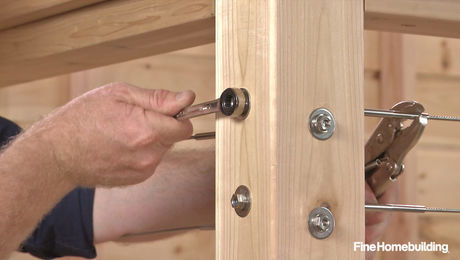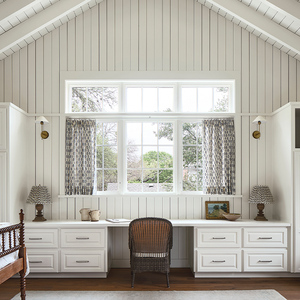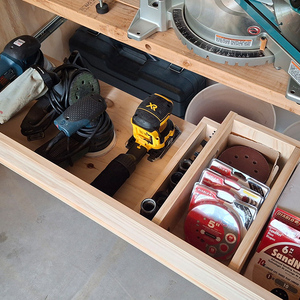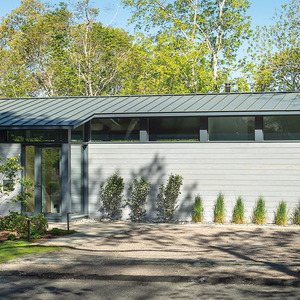Tomorrow (saturday) my contractor is (hopefully) going to get the electrical finished in the kitchen renovation and start putting up the drywall and mudding.
We have the doors all sealed off with plastic and tape, but other than that- what is the best way to keep the dust from sanding down to a minimum (someone suggested a humidifier– does that work?), and to clean up thoroughly before it has a chance to filter into the house?
All suggestions welcome!
Discussion Forum
Discussion Forum
Up Next
Video Shorts
Featured Story

Join some of the most experienced and recognized building professionals for two days of presentations, panel discussions, networking, and more.
Featured Video
How to Install Cable Rail Around Wood-Post CornersHighlights
"I have learned so much thanks to the searchable articles on the FHB website. I can confidently say that I expect to be a life-long subscriber." - M.K.
Fine Homebuilding Magazine
- Home Group
- Antique Trader
- Arts & Crafts Homes
- Bank Note Reporter
- Cabin Life
- Cuisine at Home
- Fine Gardening
- Fine Woodworking
- Green Building Advisor
- Garden Gate
- Horticulture
- Keep Craft Alive
- Log Home Living
- Military Trader/Vehicles
- Numismatic News
- Numismaster
- Old Cars Weekly
- Old House Journal
- Period Homes
- Popular Woodworking
- Script
- ShopNotes
- Sports Collectors Digest
- Threads
- Timber Home Living
- Traditional Building
- Woodsmith
- World Coin News
- Writer's Digest


















Replies
A good taper in a remodel of an occupied house will keep sanding to a minimum if at all. I will tape your room and IF I sand, it will take 30 minutes tops.
Negative air pressure. Simply put a 20$ fan in the window blowing OUT. It should take evrything (almost) with it.
You can buy a portable air filter (power) about $300.00
If you have central heat try to keep the system off for the duration of the most messy parts. Change the filter every couple of days.
Vacuum more than sweep.
There is a certain brand of mud that claims it produces less dust. I've never used it, but it sands into larger particles that apparently don't all go airborne. Makes perfect sense. Sanding is always necessary. I use a sheet sander with a vacuum hookup on my shopvac. Its kind of a low tec version of those vacuum pole sanders the pros use. Works OK, but I still have alot of dust to clean up.
Sheetrock brand dust control joint compound. Comes in a gray bucket. It's more like a lightweight compound than the regular (green) compound so I only use it as a topping coat.
It's fine as a topping compound and it's dust control feature really does work, but the the air needs to be still or it can still get airborne. Most of the dust falls straight down. Of course, that doesn't much to keep yourself clean when sanding a ceiling.
Just be careful if anyone in the house has sensitive skin. My daughter does, and she broke out in a near full body rash while I was using dustless in a hallway to her bedroom, and it only went away after I primed it.
Tu stultus esRebuilding my home in Cypress, CAAlso a CRX fanatic!
Look, just send me to my drawer. This whole talking-to-you thing is like double punishment.
Good looking out! My step-daughter is sensitive to air! (Kidding, but she seems allergic to just about everything).Edit: I've tried that wet spounge as well. I like using it between coats. It cuts down on the sanding at the end. Shop-vac with a good filter definately helps.
Edited 1/26/2009 7:06 pm ET by arcflash
This was a comforting thread to read. Glad to know that I'm not a complete freak. When we did our kitchen (1890-95 house, lots of lath and plaster walls), I didn't sand at all after several coats of premix mud and one topping compound. There are some slight streaks, but it actually fits it into the house better - makes it look more nearly like the plaster.My motivation at the time was to improve relations with LOML, who was still finding plaster dust from the demo six months after we were done.
Assuming you have forced air HVAC, be sure they seal off the ducts, especially the return if there is one in that area. BTW - drywall dust can ruin many vacuum cleaners.
Tell me about it- I ruined a perfectly beautiful and functional vintage 1940's electolux bullet-style vacuum by using it to clean up plaster dust way back in my youth.
thanks- i'll look into those ideas.
Re the fan- i'm on the fence. I'm in the camp that believes that it is likely to spread as much dust as it eliminates. Fans are great for curing paint and dispelling fumes, but i'm not sure about dw dust.
The good thing is that the house has radiator heat- but you just reminded me that i need to wrap the radiators. We already have the AC vents sealed.
Thanks again-
The fan is not so much for purging dust from the work area as providing negative pressure to keep it from infiltrating the non-work areas. I don't do much drywall finishing, just more than I'd like, and usually in a remodel situation. I use a sponge as much as possible to smooth joints, thus avoiding some of the dust. It's tricky (time sensitive, easy to get the drywall paper too wet & grainy), slow, and somewhat messy of itsownself, but it sure cuts dust. Sounds & smells nicer too.
}}}}
Thanks for explaining the negative pressure.
In order to obtain the desired negative pressure in the work zone, I put the fan in a window blowing toward the outside.
Fan stays in place during sanding and until vacuuming is completed.
I still have to vacuum 3 times.
JimNever underestimate the value of a sharp pencil or good light.
Thanks all-
I'm not the one doing the work this time, and I'm reluctant to tell the pros what tools to use. but as far as what I can do to help keep the mess to a minimum, thanks for the info.ps- my old box fan bit the dust ages ago, and i have been unable to replace it. Have you noticed how hard they are to find? they've been replaced by " noiseless" odd-shaped contraptions.
Timely thread in the middle of a 4 unit gut a and redo with one tenent still in. DW dust major PITA can't use a fan as -30 below.
Can you expand on the sponge method? when do you use it and is the mud still damp?Can't understand why they can't make something to electricley gather dust? I have thought of buying some old TV's and setting around as I notice our TV always has a nice dust coating on it.
I have tried the sponge method, but I don't like it. It's important to use a relatively dry sponge because if you use too much water and make a "slurry", the compound will lose adhesion. Unfortunately, the less water you use, the slower the removal.
When I do use water to knock down the high spots, I prefer a rag over a sponge. I find it easier to use enough water to remove compound without using too much.
I don't use a damp sponge/rag for the final feathering. Maybe I just don't have the right technique, but I can never get it as smooth as I can with 100 or 120 grit sandpaper.
I've experimented with a couple of wet methods, and this is the one I prefer:Use a high-quality hand sprayer/plant mister to apply the water, then smooth it with a grout float. Sponges ride down into the hollows, and while they smooth, they don't flatten as well as a stiff float does.This process creates a foamy slurry, though, which needs to be wiped off with an absorbent rag.While I've used this process before, and will again, nothing beats vacuum-sanding for the crisp finished product that it leaves. I use a home-made rig I put together back in the 80s, but there are plenty of commercially-made tools out there that work just fine. For wide-open, large expanses of board, the powered PC unit gets rave reviews.To finish up, I always like to go through with a vac hose in one hand, and a springy 4" knife with sticky-back sandpaper on it in the other. Great for cleaning up inside corners.I use a Wap vacuum with disposable paper bags. I like the Wap because it isn't as noisy as the Festo and Fein units, while being much more powerful.AitchKay
I recently got a 20" 3 sp. Lasko at Lowes for 12 bucks. Use it to circulate the heat from the woodstove. They last long, I run it almost 24/7.Spheramid Enterprises Architectural Woodworks
Repairs, Remodeling, Restorations
They kill Prophets, for Profits.
I buy another box fan just about every year for jobs.
Welcome to the Taunton University of Knowledge FHB Campus at Breaktime. where ... Excellence is its own reward!
So, I've always heard the old timers used a sponge. Well,I've never met anyone who could actually do it. (my one attempt last about 30 seconds) Does anyone know how to do this Holy-Grail of
dust control?
I agree with the box fan in the window blowing out, it's slowest speed is OK.
Also, I agree that no sanding between dried coats, just a wide blade for scraping will do the best. Scraping lumps and bumps save hours of unnecessary sanding. Sand only at the end.
I have had good success. I get the dedicated drywall sponges that have a scrub (almost scotchbrite) back. As someone else said, wring it pretty dry. A buddy told me about a cousin of his that used a folded turkish towel and had near perfect finish back in the day.For those who have fought for it Freedom has a flavor the protected will never know.
Maybe I had too much water. I ended up with a mess.
Aha! Sponge technique uses something similar to a scotchbrite-- so it's more like a hybrid sponge/wet sandpaper than the regular sponge i was picturing. I can see how that would work, especially if you let the JC set up a moment until it's stiff before knocking it down with the "sponge".
Edited 1/27/2009 12:14 am ET by msm-s
I wait until it is dry, knock down any ridges with tape knife or wide blade. Use the damp sponge, if it needs a little heavier removal I use the scrub side a little, then smooth with the main side. It is fairly tight cell sponge, much finer than a grout sponge.http://tinyurl.com/dkeuduFor those who have fought for it Freedom has a flavor the protected will never know.
I get box fans at the supermarket, usually end up paying about ten bucks.
for sponging, i wrap cloth around a real sanding sponge. the kind of cloth makes the "grit". terrycloth towels make coarse sanders, t-shirts are a medium, and nice cotton oxfords make a pretty fine sander for finish coats. you can fold and flip the material a few times until you need to rinse and wring it out in the joint compound bucket full of water.Hope this helps. Rich
I use an air cleaner box, which is a fan with a triple filter that catches the dust as it passes thru.you can do similar with a cheap box fan and a pleated filter and a dampened towel taped over the intake side.
Welcome to the Taunton University of Knowledge FHB Campus at Breaktime. where ... Excellence is its own reward!
Good drywall finishers don't make a huge mess wtih mounds of dust in the corners and white dust all over. Ceilings are the worst, but they use a vac system and neg pressure created by the window fan, you should be in good shape. Don't use a humidifier unless you carefully monitor the RH inside you house. You can create a lot of problems if you don't monitor and the new drywall job will be producing a lot of humidity on it's own.
kcoyner
Consider a sweep product, just sprinkle on the drywall dust on the floor and sweep up. Something like this.
http://www.pioneersawdust.com/sani-sweep.html
Just A Guy With A Hammer
Edited 1/23/2009 9:39 pm by jagwah
Use a vacuum-sander, and be absolutely certain that there is a HEPA-rated filter in the vacuum. HEPA filters remove at least 99.97% of airborne particles 0.3 micrometers (µm) in diameter.
Three cheers for dust control mud.
Like Don said, it's best used as topping compound. Around here, it's only available from CGC - the Canadian Gypsum Company. Probably exactly the same stuff. I use it a lot.
It's awesome. I skim-coated a bedroom with it and sanded the bejeezus out of it because I'm not an excellent finisher. I had a 1/4" dust over the entire floor and none in the air.
Vacuums up well. With the dust control mud, I wouldn't think that sweeping compound is mandatory. Can't hurt, though!
I'm with Eric on sanding not being a necessity. I'm not a pro, but I make an effort to keep the work very neat when I mud. I just run a wide knife over most surfaces between coats and after texture to knock off burs, and don't really sand after that. The layers of paint will soften the look all on their own. I hold a sanding pole in one hand and look around for a few minutes, but that's it. There may be two schools of thought: fast and messy, sand a lot; or slower and technical, sand very little. Of course sanding and cleanup take time, too, so who's to say whats faster.
The more I talk about this the more it reminds me of woodworkers debates about sanding vs. planing/scraping.
Brian
I hold a sanding pole in one hand and look around for a few minutes, but that's it.
...........thinking; do I really want to start making this mess?
We are few, but certainly not alone.
In small room like baths, the drywall end up pretty much skim coated when I finish. Much easier than that mess of dust.
dust control mud, thin coats that dry fast and dont require sanding, water on knives help prevent hitch hikers and air bubbles, so does "whipping" up your mud. when sanding time comes, rent the Porter Cable drywall sander FAST and CLEAN ($30 WELL spent each time never regretted the money spent).
and constantly changing the furnace filters (at least everyday they cost a dollar or two each) so dust doesnt circulate, tape off any cold air returns in the effected area, only while your working.
Woods favorite carpenter
What yesmam said.
View Image
Although I find that it is a rather physical job using that vac-attachment, I have also used it successfully in homes with COPD patients. The HEPA filter is absolutely essential there. I found that the hose was too short to make ceiling-work easy, so I added another 4 or 5 feet that I found somewhere. And I have found that the little air valve in the handle is valuable -- too much suction means that the sanding head sticks to the drywall, too little means you're not collecting enough dust.Note that I only use the vac-attachment when I'm working on an occupied residence. When I'm on an empty-house job, I use a pole sander and nothing else, except a dust mask.
Politics is the antithesis of problem solving.